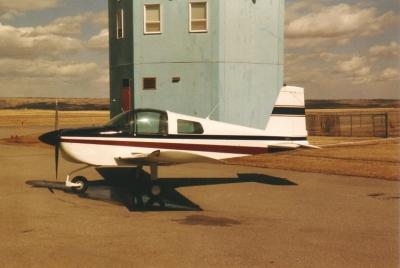Two Fatally Injured When AA-1A Airplane Went Down During Firefighter Recreation Day
The NTSB has released a preliminary report from an accident which occurred June 9th that resulted in two fatal injuries.

According to the report, at about 1115 PDT, an American Aviation AA-1A, N9454L, collided with the dry surface of El Mirage Lake, in El Mirage, California. The airplane was co-owned, and operated by the pilot under the provisions of 14 Code of Federal Regulations Part 91. The commercial pilot and passenger sustained fatal injuries. The airplane was destroyed during the accident sequence. The local personal flight departed from the El Mirage Lakebed, about 1100. Visual meteorological conditions prevailed, and no flight plan had been filed.
Members of the Los Angeles Fire Department (LAFD) had organized an off-duty recreation day at the lakebed. The group was comprised of about 12 people, and included family and friends. A combination of activities was planned, including camping, along with flying both the accident airplane and powered paragliders. The accident pilot was a fire helicopter pilot, assigned to the air operations division of the LAFD.
About 0930, the pilot departed with one of his daughters in the accident airplane to perform a sightseeing flight in the local area. The flight departed from the lakebed in a southerly direction in light and variable winds, and lasted about 15 minutes. A short time later he flew his second daughter on a similar flight, for a similar amount of time.
For the third, and accident flight, the group requested that the pilot perform a "low-pass" over the north shore of the lakebed, where everyone had assembled.
According to witnesses, the flight departed again to the south, but this time the wind had picked up such that a left crosswind existed during takeoff. The flight progressed as before, and after about 15 minutes the airplane approached the group from the northwest, at a low altitude for what was presumed to be the low-pass. The airplane flew over the group about 100 feet agl, and after passing initiated a climbing right crosswind turn to the south. Witnesses reported that as the airplane turned from crosswind to downwind, the bank angle became "excessive," with some witnesses assuming the pilot was either positioning the airplane to land, or returning for a second low-pass. The airplane did not level after the bank. The nose then pitched down, and the airplane descended into the ground at a 45-degree nose-down angle.
The accident site was located on the western side of the lakebed, at an elevation of 2,841 feet msl.
The lakebed was comprised of smooth, hard-packed soil, with the first identified point of impact including a series of 2-inch-deep ground disruptions. Ground scars continued 10-feet further, on a bearing of 320 degrees magnetic, and included debris consisting of green wingtip navigation lens fragments and the nose landing gear strut. The engine starter ring and alternator belt were located adjacent to the scars. The propeller, nose landing gear, shards of red wing tip navigation lens, along with the pitot tube (mounted at the left wingtip, underside) were a further 30-feet down range.
The main wreckage came to rest about 160 feet beyond the first impact point. The cabin area rested upright on a bearing of 170 degrees and sustained crush damage from the firewall through to the passenger seat bulkhead. The flight controls were fragmented, and all flight instruments were detached from the panel. The tail section was intact, upright, and undamaged. The engine mount had detached from the airframe, with the engine remaining partially attached to the firewall via control cables and hoses.
Both wings had separated from the center spar, and remained loosely oriented perpendicular to the main cabin. The right wing was inverted, with the outboard section of the leading edge crushed at a 45-degree angle towards the trailing edge of the wing tip. The left wing came to rest leading edge up, and sustained leading edge crush damage along its entire length. Both wing spar fuel tanks were breached, and the odor of automotive gasoline was present at the site. The magneto switch was observed in the both position; additionally, the fuel selector valve was in the right wing tank position. The carburetor heat, throttle, and fuel mixture controls were in the full forward position. The flap actuator was set to the fully retracted flap position.
All major components of airplane were accounted for at the accident site, and the airframe was free of any indications of bird strike.
(Image from file. Not accident airplane)
 Unfortunate... ANN/SportPlane Resource Guide Adds To Cautionary Advisories
Unfortunate... ANN/SportPlane Resource Guide Adds To Cautionary Advisories ANN FAQ: Turn On Post Notifications
ANN FAQ: Turn On Post Notifications ANN's Daily Aero-Term (04.29.24): Visual Approach Slope Indicator (VASI)
ANN's Daily Aero-Term (04.29.24): Visual Approach Slope Indicator (VASI) ANN's Daily Aero-Term (04.28.24): Airport Marking Aids
ANN's Daily Aero-Term (04.28.24): Airport Marking Aids ANN's Daily Aero-Linx (04.28.24)
ANN's Daily Aero-Linx (04.28.24)



